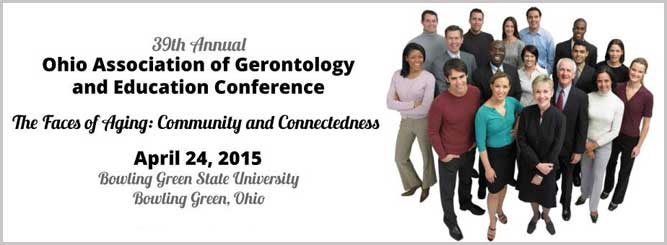Paper Session VI - Issues Affecting Caregiving
Location
BTSU 308
Start Date
24-4-2015 1:45 PM
End Date
24-4-2015 2:45 PM
Description
Purpose statement (objectives) This examination seeks, • first, to sensitize gerontologists to some of the adversities and prospects faced by grandparents raising grandchildren; • second, to provide an overview of current research and theory regarding the demographic through both a phenomenological and a life-course perspective—and a more recent theoretical lens of Generational Intelligence—for inter-generational work; and • third, to suggest implications for future interventions with skipped-generation families. Descriptive narrative of the presentation Generations United reports [Family Matters: Multigenerational Families in a Volatile Economy (2011)] that more than 51.4 million Americans of all ages (about one in six) live in multi-generational households—an increase of over 10% since the start of the Great Recession in 2007. Though reasons vary, multi-generational households are an increasingly significant part of the socioeconomic fabric of the United States, reversing the long-term trend towards living in nuclear families. In addition, a 2010 Pew Research (Pew Social and Demographic Trends, “The Return of the Multi-Generational Family Household”) report indicates growing numbers of grandparent-headed, “skipped generation” households, with grandparents assuming a custodial parenting role for their grandchildren. Though the skipped generation household provides certain mutual benefits in tough economic times as it widens the family system and provides greater support, both economically and socially, it also presents unique challenges. With more than 2.7 million grandparents responsible for most of their grandchildren’s basic needs, significant numbers of these grandparents live below the poverty line, are still in the workforce, or have significant disabilities. The increase of this demographic has outpaced the growth of policies and services that address the unique challenges that grandfamilies pose.
Included in
Closing the Gap between Skipped-generation Households and Available Resources and Services
BTSU 308
Purpose statement (objectives) This examination seeks, • first, to sensitize gerontologists to some of the adversities and prospects faced by grandparents raising grandchildren; • second, to provide an overview of current research and theory regarding the demographic through both a phenomenological and a life-course perspective—and a more recent theoretical lens of Generational Intelligence—for inter-generational work; and • third, to suggest implications for future interventions with skipped-generation families. Descriptive narrative of the presentation Generations United reports [Family Matters: Multigenerational Families in a Volatile Economy (2011)] that more than 51.4 million Americans of all ages (about one in six) live in multi-generational households—an increase of over 10% since the start of the Great Recession in 2007. Though reasons vary, multi-generational households are an increasingly significant part of the socioeconomic fabric of the United States, reversing the long-term trend towards living in nuclear families. In addition, a 2010 Pew Research (Pew Social and Demographic Trends, “The Return of the Multi-Generational Family Household”) report indicates growing numbers of grandparent-headed, “skipped generation” households, with grandparents assuming a custodial parenting role for their grandchildren. Though the skipped generation household provides certain mutual benefits in tough economic times as it widens the family system and provides greater support, both economically and socially, it also presents unique challenges. With more than 2.7 million grandparents responsible for most of their grandchildren’s basic needs, significant numbers of these grandparents live below the poverty line, are still in the workforce, or have significant disabilities. The increase of this demographic has outpaced the growth of policies and services that address the unique challenges that grandfamilies pose.


